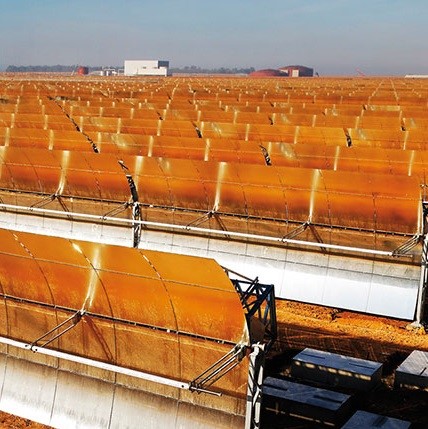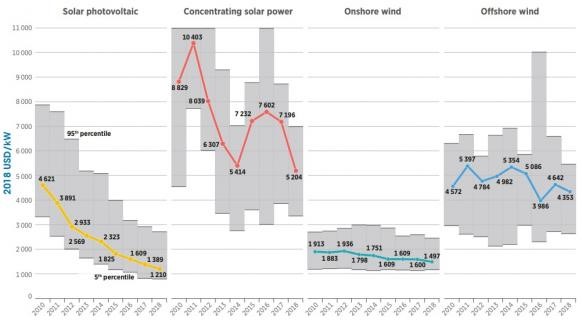The country has expanded its renewables target at the Shagaya Renewable Energy Complex to 4 GW
KUWAIT CITY, Kuwait, 4 July 2019: Kuwait has expanded its 2030 renewables target at the Shagaya Renewable Energy Complex to 4 GW, but CSP developers will have to wait until a third phase of development, due online in 2025-26, to secure projects, Osamah Alsayegh, Executive Director of Energy & Building Research Center at KISR, according to a New Energy Update report.

Kuwait is expanding its Shagaya renewable energy park but CSP will play a smaller role than originally expected. (Photo courtesy MMYPEM)
In February, Kuwait started commercial operations at its 50 MW Shagaya CSP plant, marking the completion of phase 1 of the Shagaya Renewable Energy Park, the report said.
Developed by the Kuwait Institute for Scientific Research (KISR), the Shagaya Park was launched in 2012 and was originally expected to host 2 GW of capacity by 2030, across three phases, the report said. KISR initially recommended a generation mix at the park of 56% CSP capacity – equivalent to 1.15 GW – alongside 35% PV and 7.5% wind, the report said.
Kuwait’s electricity demand is expected to triple by 2030, and the Shagaya complex forms part of Kuwait’s target to generate 15% of its electricity from renewable sources, the report said.
KISR has now decided to add a fourth phase to the park and raise its 2030 target at the site to 4 GW, but CSP developers will miss out on much of this expansion, the report quoted Alsayegh as saying.
In phase 2, Kuwait National Petroleum Company (KNPC) will develop 1.5 GW of capacity and has decided to install 100% PV technology, despite KISR recommending 20-30% CSP capacity to improve dispatchability, the report said.
As a result, CSP capacity at Shagaya will be far below KISR’s initial recommendations, and developers will have to wait until phase 3 to bid for projects, the report quoted Alsayegh as saying.
Kuwait plans to implement a Public-Private Partnership (PPP) model to attract private-sector investment for phases 3 and 4, the report said. For phase 3, KISR has recommended an “optimum configuration” of 1,200 MW PV, 200 MW CSP and 100MW wind, based on preliminary studies of market requirements, the report quoted Alsayegh as saying.
Kuwait authorities are now preparing tender papers for phase 3, and the capacity is expected to come online by 2025-26, the report quoted Alsayegh as saying.
KISR’s latest analysis shows that Kuwait CSP capacity will not exceed 400 MW by 2030, which is an optimistic projection, the report further quoted Alsayegh as saying.
Spinning reserve
KNPC likely favoured PV technology for the phase 2 project, due to faster deployment timelines, lower costs and adequate online dispatchable capacity, the report quoted Alsayegh as saying.
Installed costs of CSP, PV and wind in 2010-2018

Source: International Renewable Energy Agency’s “Renewable Power Generation Costs in 2018” report, May 2019
According to the report, following completion of phase 1, KISR transferred ownership of the Shagaya development to the Ministry of Electricity & Water (MEW), which is the country’s sole electricity producer and distributor. KNPC was advised by the MEW that there is currently enough spinning reserve to omit CSP capacity and deploy solely PV technology in this phase, the report said.
Growing PV and wind penetration improve the business case for CSP plants with storage to provide dispatchable power to the grid, the report noted. However, Kuwait’s power generation mix will remain dominated by fossil fuel generation, limiting the appeal of CSP, the report said.
The 60MW KOC Solar EOR facility is the only other CSP project active in Kuwait’s pipeline, and the project has stalled at the planning phase, according to the CSP Global Tracker, the report said.
Park infrastructure
The phase 2 development is currently in the EPC tendering process, the report said, adding that up to eight international consortiums were expected to bid for the EPC contract, which will be developed under an engineering, procurement and construction plus-finance (EPC+F) contract. “Construction is expected sometime in the fall, with a commercial operations target of 2022/23,” the report quoted Alsayegh as saying. The Phase 2 project will benefit from infrastructure and local skills networks put in place during the eight-year development of phase 1.
According to the report, KISR and its partners tackled land acquisition, permitting and licensing challenges, and built out grid connections. “This is a remote site with no infrastructure so KISR had to coordinate with the MEW to build a substation and overhead lines,” the report quoted Alsayegh as saying.
Despite the progress, further challenges remain, the report said. Kuwait currently has no power-purchase-agreement (PPA) framework in place and lacks the streamlined national renewables strategy used by other Gulf Cooperation Council (GCC) markets, such as the UAE and Saudi Arabia, the report added.
Early learnings
CSP developers planning for phase 3 projects will gain from improved park infrastructure and learnings from the 50 MW Shagaya CSP plant, the report said. Four months into commercial operations, the Shagaya CSP plant is “performing well,” the report quoted Alsayegh as saying. The plant must be tested through all seasons of the year to determine whether target energy levels will be met, the report quoted Alsayegh as noting. “We are now starting to collect data and understand how it is performing against our weather conditions and consulting this information with the project stakeholders,” the report further quoted Alsayegh as saying.
According to the report, in April, construction and engineering group, MMYPEM said it was performing maintenance works at the plant to “improve the functioning of the energy storage system.” MMYPEM assembled the solar field, balance of plant equipment and turbine for the plant. The maintenance was expected to last “several months”, the report quoted MMYPEM as saying.
Water boost
Like many Middle East projects, the Shagaya plant is subjected to high temperatures, dust and humidity, which raises significant cleaning and water supply challenges, the report said. The plant was expected to require 40,000 cubic metres of water per year, the report quoted Itziar Azpitarte, Marketing Director at Spanish technological center, IK4-Tekniker, as saying in 2017.
According to the report, the Shagaya site is not connected to the national water pipe network, and operations teams must transport water to the site via tankers. This introduces additional costs and water supply risks, the report said, adding that advanced technologies could help minimise these risks, going forward.
According to the report, in Europe, the EU-funded WASCOP research project aims to reduce water consumption of CSP plants by 70-90% and boost power output by 2-3%. IK4-Tekniker is a partner in the project, and tests at the Shagaya CSP plant showed WASCOP’s technologies can reduce cleaning frequency by almost 65%, the report quoted Azpitarte as saying.
Future CSP plants could also benefit from plans to expand water supply in the region, the report quoted Alsayegh as saying. “The MEW is expected to buildout water infrastructure to meet the industrial and residential growth in the area,” the report quoted Alsayegh as saying, “which would benefit the plant.”
Copyright © 2006-2025 - CPI Industry. All rights reserved.